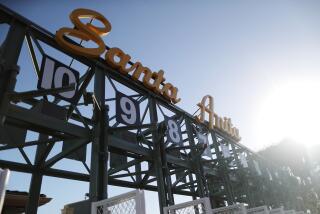For Traditional Fairs, the Shows Go On Despite Spiraling Expenses
- Share via
When the Pointer Sisters all caught the flu and had to cancel a sold-out show, Maynard Potter faced the biggest crisis in the history of the California Mid-State Fair in Paso Robles.
Big-name entertainers, after all, have evolved into the lifeblood not only of state fairs but district and county fairs as well. Potter, the fair’s general manager, knew that an empty stage at the fairgrounds might not only cost the fair tens of thousands of dollars in revenues, but also ruin its reputation.
“These acts make the fair,” Potter said. “It’s the difference between surviving and dying.”
The Show Went On
So Potter made some quick calls and at the last minute booked Ray Charles. The show went on and the fair’s reputation stayed intact. But the high costs of booking these big-name acts, along with the fast-rising costs of liability insurance, have fair officials concerned about the direction of the industry.
The spiraling costs of putting on fairs are the key concern being voiced by 1,400 delegates from 150 fairs in 27 states and five Canadian provinces who are attending the Western Fairs Assn. (WFA) annual meeting and convention in Anaheim this week.
“Everyone’s biggest concern is rising costs,” said Norb Bartosik, president of the WFA and manager of the Orange County Fair.
Big-name entertainers such as Kenny Rogers and Johnny Cash can cost more than $100,000 per show. Alabama, which five years ago was commanding just $5,000 per show, is now pulling in close to $150,000, according to fair industry executives.
Record Revenues
Fairs can no longer be just fair--especially in California, where the competition includes Disneyland and Universal Studios. Yet even with that, the California fair industry posted record revenues of $639.5 million in 1985.
This growth is not happening by accident. Much like the sister amusement-park industry, the fair industry is growing up and moving away from the ring-toss games, nameless country-and-Western singers and cotton candy on cardboard cones that once were the staples of the industry.
Today, fair-goers are likely to find high-tech attractions, Las Vegas entertainers and food booths with menu selections as current as latest trends in the restaurant industry.
Hand in hand with these improvements, however, come rising costs--most recently in the insurance sector. The Orange County Fair was lucky to see its insurance costs rise just 35% this year when some smaller fairs are seeing their insurance premiums jump tenfold, Bartosik said.
Even the cost and size of midway prizes are reaching new heights. Forget stuffed teddy bears. At last year’s Los Angeles County Fair, the most popular prize was a 20-foot long stuffed snake, said Hank Mackin, sales manager for Fable Toy Co. of New York. His division sold the fair 7,000 of the stuffed snakes, which retail at $39--and wholesale for $16.
“The toys you’ll find in the Broadway (department stores) you can now win on the midway,” said Paul Nemeth, a San Antonio-based concessionaire who runs concessions at the Los Angeles County, Orange County and California State fairs.
Year-Round Use
To compensate for these rising costs, fair officials and participants are being forced to dream up new ways to generate income. Chief among them is a growing trend toward full-year use of fairgrounds.
“A fair is not a fair anymore. It’s a fairgrounds,” Bartosik said. At the Orange County fairgrounds, for example, nearly $6.5 million of the $9-million annual gross income is generated between fair dates, Bartosik said. The biggest moneymakers are events such as weekend swap meets, concerts and horse races.
Similarly, the six-day Farmer’s Fair of Riverside County in Hemet gets nearly 40% of its revenues from off-season events ranging from dog shows to demolition derbies.
Also, instead of selling full-use tickets that allow fair-goers to attend concerts by name acts for no extra charge, many fairs have begun selling separate concert tickets. At the Paso Robles fairgrounds, for example, customers paid $8 to $15 to see big-name stars last year.
Big Names in Demand
But that hasn’t stopped fans from flocking to the shows. And the demand for name entertainment is greater than ever.
“Some county fairs are even coming up with bigger entertainment budgets than state fairs,” said Terry Hill, president of Hill-Davis Productions, the Woodland Hills firm that represents stars ranging from Carol Lawrence to the Kingston Trio.
Superstars such as Johnny Cash, who once only played giant state fairs, are now doing county fairs as well, said Bonnie Sugarman, special events coordinator at Agency for the Performing Arts of Los Angeles, which represents Cash.
Then there are the really big acts. Last year the Orange County Fair featured an 84-foot-tall inflatable King Kong on the grounds. The $18,000 giant gorilla didn’t act, dance or sing, Bartosik said, “but it sure brought in the crowds.”
More to Read
Sign up for Essential California
The most important California stories and recommendations in your inbox every morning.
You may occasionally receive promotional content from the Los Angeles Times.













